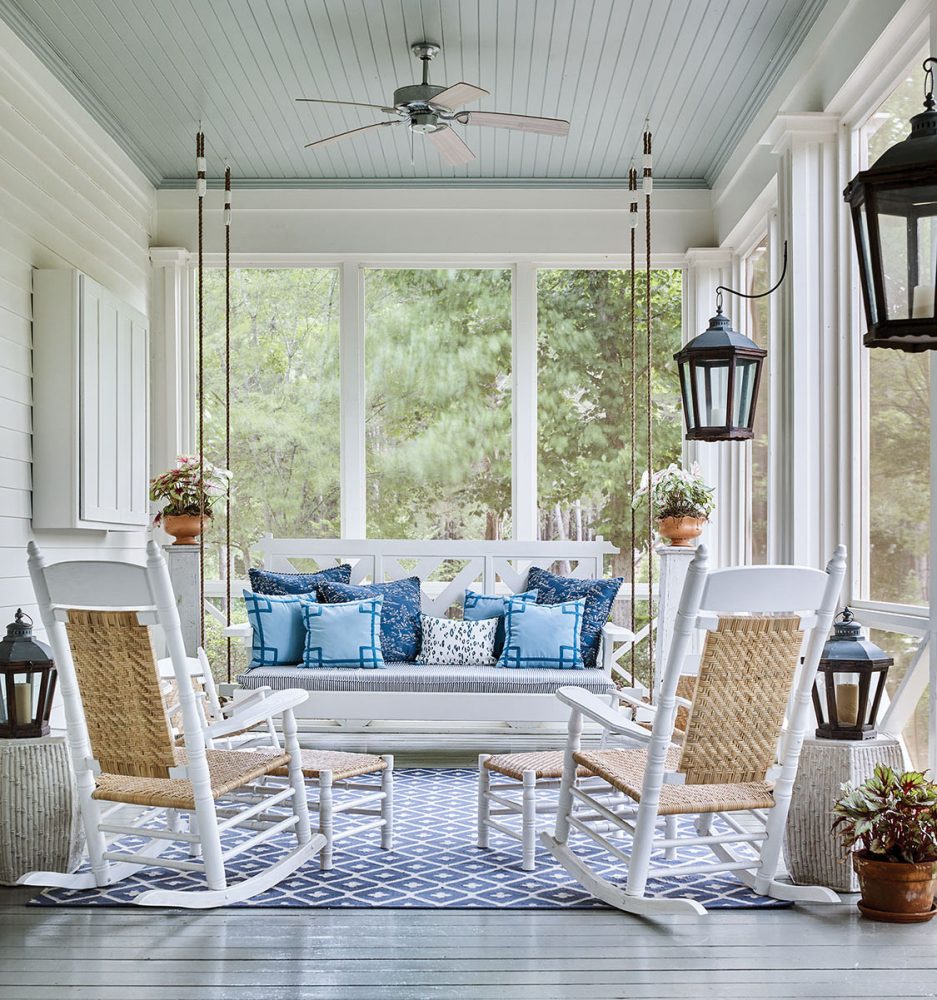[vc_row][vc_column][vc_column_text]

Every public building in Colonial Williamsburg is decorated to celebrate the season. Here, each window on the Governor’s Palace is perfectly punctuated with an evergreen wreath.
Colonial Williamsburg, known for its historical and political significance to the founding of the United States, is also responsible for another American tradition—Christmas wreaths! In the 1920s the Rockefellers began their ambitious preservation and restoration project. They endeavored to return Williamsburg to its original colonial structure and to preserve it for public tours. Prior to the 20th century, Christmas had primarily been a religious observance marked by simplicity and frugality. But as the century roared on, the holiday became a commercial success and along with it, lavish decorations. The decorators at Colonial Williamsburg knew that tourists would expect some trimmings so they put up trees with multi-colored lights. The modern lights were ill-received for being so obviously in conflict with the historic nature of the town. The decorators took note. Instead of technicolored bulbs, they used natural elements like fruit in the Della Robbia style to adorn their garlands and wreaths. Visitors saw the wreaths and were charmed by the idea of adding extra elements to a simple green trimmed wreath. The trend spread rapidly as Christmas decor became more and more extravagant over the years. Today, our wreath decor has expanded to include bows, baubles, and faux frosted pinecones, but the keepers of Colonial Williamsburg still stick with natural, found elements, creating an authentic experience for the visitors as well as creating a treat for the eyes.[/vc_column_text][/vc_column][/vc_row][vc_row][vc_column][vc_single_image image=”262294″ img_size=”large” add_caption=”yes” alignment=”center”][/vc_column][/vc_row][vc_row][vc_column][vc_column_text]Colonial Williamsburg holds an annual Christmas decorating competition to honor its role in the 20th century wreath trend. The competition helps decorate the town, but it also keeps visitors coming for tours to see the designer’s creativity on display. Participants must decorate the entrance to their house, and they must only use materials that would have been available to Williamsburg residents before the Revolutionary War (any flora that was introduced to the States afterwards does not count). Residents often use the colors of their home as inspiration. Some participants include a theme or a nod to their home’s historical use. Entries are judged on creativity, originality, and their faithfulness to the spirit of 18th century decorative ideas. We love the idea of a botanical competition, and below we’ve compiled some of our favorite entries for you to be the judge![/vc_column_text][/vc_column][/vc_row][vc_row][vc_column][vc_column_text]
Cinnamon and Oranges
[/vc_column_text][/vc_column][/vc_row][vc_row][vc_column][vc_single_image image=”262275″ img_size=”large” add_caption=”yes” alignment=”center”][/vc_column][/vc_row][vc_row][vc_column][vc_column_text]As contestants are required to use only natural materials that would have been available to residents of Williamsburg leading up to the Revolutionary War, this decorator opted for age old Christmas classic– oranges. Cotton stars, scored dried limes, and dried white yarrow complete the design. The fresh fruits and flora make it an iconic Della Robbia wreath.[/vc_column_text][/vc_column][/vc_row][vc_row][vc_column][vc_column_text]
Pomegranate Pop
[/vc_column_text][/vc_column][/vc_row][vc_row][vc_column][vc_single_image image=”262290″ img_size=”large” add_caption=”yes” alignment=”center”][/vc_column][/vc_row][vc_row][vc_column][vc_column_text]Inspired by the building’s past as a tavern, vintage silver plates enhance a wreath of Fraser Fir, pomegranates, pinecones, green leaves and a light blue ribbon.[/vc_column_text][/vc_column][/vc_row][vc_row][vc_column][vc_column_text]
Wreath of Hope
[/vc_column_text][/vc_column][/vc_row][vc_row][vc_column][vc_single_image image=”262877″ img_size=”large” add_caption=”yes” alignment=”center”][/vc_column][/vc_row][vc_row][vc_column][vc_column_text]A dove made of white paper symbolizes peace for this pine wreath. Tags on twine were added around the doorway and pine wreath, inspired by the tree tagging tradition at the Williamsburg Inn. Passersby added their own tags with hopes for the new year written on them.[/vc_column_text][/vc_column][/vc_row][vc_row][vc_column][vc_column_text]
Flora and Fauna
[/vc_column_text][/vc_column][/vc_row][vc_row][vc_column][vc_single_image image=”262287″ img_size=”large” add_caption=”yes” alignment=”center”][/vc_column][/vc_row][vc_row][vc_column][vc_column_text]This dramatic but elegant wreath relied on non-traditional elements such as mushrooms, dried artichokes, and pitcher plants. The small tin cup was representative of the tavern. Drying the flora before hanging it prevents the wreath from rotting, making the upkeep easier. The pheasant feathers are used to create a bow-like shape.[/vc_column_text][/vc_column][/vc_row][vc_row][vc_column][vc_column_text]
Simple Dried Flowers
[/vc_column_text][/vc_column][/vc_row][vc_row][vc_column][vc_single_image image=”262289″ img_size=”large” add_caption=”yes” alignment=”center”][/vc_column][/vc_row][vc_row][vc_column][vc_column_text]The designer wanted to celebrate the beauty of ingredients that usually get thrown away– bare stems. They used wheat, red celosia, dried lotus pods, and a dried sunflower on a Fraser fir wreath. The flowers hung on this wreath dry over time, creating a simple but stylish look. The blue patterned scarf holds the elements together, while adding a touch of color and staying within the rules of 18th century materials.[/vc_column_text][/vc_column][/vc_row][vc_row][vc_column][vc_column_text]
Mushrooms and Moss
[/vc_column_text][/vc_column][/vc_row][vc_row][vc_column][vc_single_image image=”262277″ img_size=”large” add_caption=”yes” alignment=”center”][/vc_column][/vc_row][vc_row][vc_column][vc_column_text]The purple reindeer moss and yellow strawflowers contrast in color to invite your eyes to move around the piece. Mounted on a grapevine wreath are dried pitcher plant, nigella, strawflowers, reindeer and spanish moss. The arrangement looks foraged and creates a wild and whimsical feel.[/vc_column_text][/vc_column][/vc_row][vc_row][vc_column][vc_column_text]
Flower Power
[/vc_column_text][/vc_column][/vc_row][vc_row][vc_column][vc_single_image image=”262291″ img_size=”large” alignment=”center”][/vc_column][/vc_row][vc_row][vc_column][vc_column_text]Fresh apples, celosia, strawflowers, white yarrow flowers, and dandelions cover this fluffy evergreen wreath. The pinecones are pulled open to create the look of flowers. Flower-shaped pinecones last longer than regular flowers and are easier to find in the winter months.[/vc_column_text][/vc_column][/vc_row][vc_row][vc_column][vc_column_text]
Seaside Simplicity
[/vc_column_text][/vc_column][/vc_row][vc_row][vc_column][vc_single_image image=”262284″ img_size=”large” alignment=”center”][/vc_column][/vc_row][vc_row][vc_column][vc_column_text]This decorator used dried artemisia as a base instead of evergreen stems. The elements mounted on a grapevine wreath with lotus pods, dried pomegranates, dried Celosia and seashells found from the nearby James River. These soft details create a laidback, seaside arrangement.[/vc_column_text][/vc_column][/vc_row][vc_row][vc_column][vc_separator el_width=”30″][/vc_column][/vc_row][vc_row][vc_column width=”1/2″][vc_column_text]
What is Della Robbia style?
The Della Robbia style is referring to the work of a 15th century sculptor named Luca della Robbia. He is known for creating round religious plaques out of terracotta and glaze. He would often put seasonal fruits and vegetables around the border of his plaques, creating the illusion of a wreath. In a 1926 House Beautiful article about the Colonial Williamsburg wreaths, the writer stated “This idea was undoubtedly suggested by the gorgeous Italian carvings and terra cottas of the Renaissance.” When decorators added fruit a few years later, it was declared the “Della Robbia” style.[/vc_column_text][/vc_column][vc_column width=”1/2″][vc_single_image image=”262282″ img_size=”large” alignment=”center”][/vc_column][/vc_row][vc_row][vc_column][vc_separator][/vc_column][/vc_row][vc_row][vc_column][vc_column_text]By Carrie Clay
Photography by David Hillegas
More Christmas and Holiday Decorations
- Christmas Window Decor
- Christmas Tree Ideas
- Christmas Door Decor
- Christmas Mantel Decorations
- Holiday and Christmas Wreath Ideas
- Christmas Flower Arrangements
[/vc_column_text][/vc_column][/vc_row]




